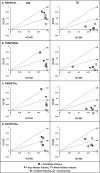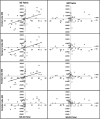Genetic and Environmental Influences on Lobar Brain Structures in Twins With Autism
- PMID: 31711118
- PMCID: PMC7444733
- DOI: 10.1093/cercor/bhz215
Genetic and Environmental Influences on Lobar Brain Structures in Twins With Autism
Abstract
This investigation examined whether the variation of cerebral structure is associated with genetic or environmental factors in children with autism spectrum disorder (ASD) compared with typically developing (TD) controls. T1-weighted magnetic resonance imaging scans were obtained from twin pairs (aged 6-15 years) in which at least one twin was diagnosed with ASD or both were TD. Good quality data were available from 30 ASD, 18 discordant, and 34 TD pairs (n = 164). Structural measures (volume, cortical thickness, and surface area) were generated with FreeSurfer, and ACE modeling was completed. Lobar structures were primarily genetically mediated in TD twins (a2 = 0.60-0.89), except thickness of the temporal (a2 = 0.33 [0.04, 0.63]) and occipital lobes (c2 = 0.61 [0.45, 0.77]). Lobar structures were also predominantly genetically mediated in twins with ASD (a2 = 0.70-1.00); however, thickness of the frontal (c2 = 0.81 [0.71, 0.92]), temporal (c2 = 0.77 [0.60, 0.93]), and parietal lobes (c2 = 0.87 [0.77, 0.97]), and frontal gray matter (GM) volume (c2 = 0.79 [0.63, 0.95]), were associated with environmental factors. Conversely, occipital thickness (a2 = 0.93 [0.75, 1.11]) did not exhibit the environmental contributions that were found in controls. Differences in GM volume were associated with social communication impairments for the frontal (r = 0.52 [0.18, 0.75]), temporal (r = 0.61 [0.30, 0.80]), and parietal lobes (r = 0.53 [0.19, 0.76]). To our knowledge, this is the first investigation to suggest that environmental factors influence GM to a larger extent in children with ASD, especially in the frontal lobe.
Keywords: FreeSurfer; cortical thickness; frontal lobe; heritability; social communication.
© The Author(s) 2019. Published by Oxford University Press. All rights reserved. For permissions, please e-mail: journals.permission@oup.com.
Figures


References
-
- Baare WF, Hulshoff Pol HE, Boomsma DI, Posthuma D, Geus EJ, Schnack HG, Haren NE, Oel CJ, Kahn RS. 2001. Quantitative genetic modeling of variation in human brain morphology. Cereb Cortex. 11:816–824. - PubMed
-
- Baio J, Wiggins L, Christensen DL, Maenner MJ, Daniels J, Warren Z, Kurzius-Spencer M, Zahorodny W, Robinson Rosenberg C, White T et al. . 2018. Prevalence of autism spectrum disorder among children aged 8 years-autism and developmental disabilities monitoring network, 11 sites, United States, 2014. MMWR Surveill Summ. 67:1–23. - PMC - PubMed
-
- Bartley AJ, Jones DW, Weinberger DR. 1997. Genetic variability of human brain size and cortical gyral patterns. Brain. 120(Pt 2):257–269. - PubMed
-
- Benjamini Y, Hochberg Y. 1995. Controlling the false discovery rate: a practical and powerful approach to multiple testing. J R Stat Soc. 57:289–300.
Publication types
MeSH terms
Grants and funding
LinkOut - more resources
Full Text Sources
Medical
Miscellaneous

